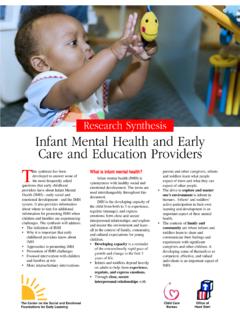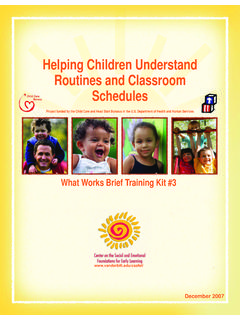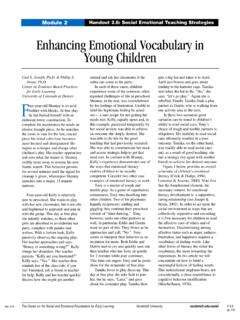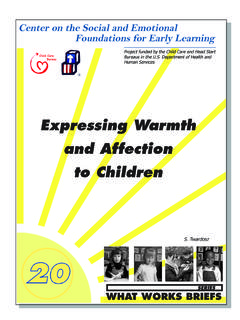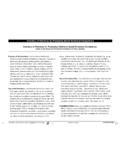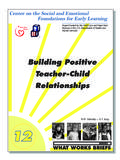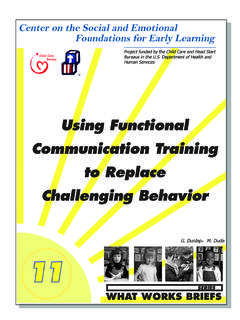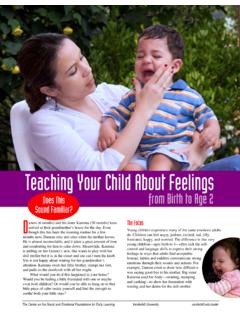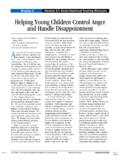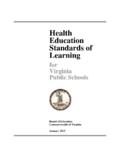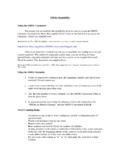Transcription of Fostering Emotional Literacy in Young Children: …
1 Center on the Social and EmotionalFoundations for Early LearningFostering EmotionalLiteracy in YoungChildren: LabelingEmotionsProject funded by the Child Care and Head StartBureaus in the Department of Health andHuman ServicesWHAT WORKS BRIEFSSERIESG. Joseph P. Strain M. M. OstroskyThis What Works Brief is part of a continuing series ofshort, easy-to-read, how to information packets ona variety of evidence-based practices, strategies, andintervention procedures. The Briefs are designed forin-service providers and others who conduct staffdevelopment activities. Those who are responsible forprofessional development should find them useful insharing information with professionals and parents tohelp teachers and other caregivers support youngchildren s social and Emotional development.
2 TheBriefs include examples and vignettes that illustratehow practical strategies might be used in a variety ofearly childhood settings and home described in the Briefs are most successfulwhen used in the context of ongoing positiverelationships and supportive environments. Thestrategies are most successful for an individual childwhen developed based on observation andassessment of the child including information from thefamily, teacher, and other Emotional Literacy inYoung children : Labeling EmotionsFour-year-old Gregory is an avid block builder. At free play, he has busied himself with an elaborate construction of a complete his masterpiece, he needs an elusive Y-shaped block. As he searches the room in vain for the last, crucial piece,his initial calm hunt becomes more hurried and disorganized.
3 He begins to yell and disrupt other children s play. Gregory seesthat his classmate Malik has the piece he wants. Gregory aggressively approaches Malik, who looks frightened. His teacherapproaches in the nick of time and asks, What s the matter? Gregory screams that Malik has his block and then swiftly turnsaway to go after the piece. Gregory s teacher stops him from grabbing the block, whereupon Gregory launches into a majortantrum. The tantrum persists even though his teacher repeatedly tells him to calm down. Keisha is 4 years old and loves to play at the computer. The computer area is her first choice at center time, just about everyday. Today, Keisha is getting nervous because her teacher has called upon most of the boys and girls to decide where theywould like to play first and Keisha notices that there is just one space left at the computers.
4 She starts to bounce a little with herhand extended in the air and tries her best not to call out to the teacher, Me next! When Keisha finally gets called on to makeher choice, she sees that the computer area is full. Keisha crosses her arms across her chest and frowns. Her teacher asks, Keisha, what is the matter? Keisha says, I wanted to play on the computer. Her teacher replies, they look full. Keisha replies, Yeah, I m frustrated and a little mad. Her teacher responds, You feel frustrated and a little mad, huh? Well,that is a problem. Keisha begins to take some deep breaths and then proclaims, I will go play at the block corner until Bahtais done. Can you come tell me when he is finished? Her teacher replies, I am so proud of you for staying so calm andfiguring out a solution to your problem.
5 Why don t you ask Bahta to let you know when it is your turn? Keisha smiles at thesuggestion and skips off to make the request of Is Emotional Literacy ? Emotional Literacy is the ability to identify, understand, andrespond to emotions in oneself and others in a healthy who have a strong foundation in Emotional literacytolerate frustration better, get into fewer fights, and engage inless self-destructive behavior than children who do not have astrong foundation. These children are also healthier, less lonely,less impulsive, more focused, and they have greater academicachievement. The focus of this What Works Brief is on buildingan Emotional vocabulary. The development of a feeling wordvocabulary is considered to be of critical importance in a child semotional development because it makes it possible for childrento better understand their Emotional experiences.
6 The ability toname a feeling allows children to discuss and reflect with othersabout their personal experience of the world. The larger a child semotional vocabulary, the finer discriminations they can makebetween feelings and the better they can communicate withothers about their who are able to label their emotions are on their way tobecoming emotionally competent. In the above two scenarios,great variation can be noted in the children s skills in labelingemotions. Gregory is unable to label his feeling of frustration,and at the same time, he is unable to read his peer s frightenedexpression and calm himself down. Keisha, on the other hand, isable to correctly identify her feelings, control her impulses toyell out, regulate her disappointment in a healthy way, and solvean interpersonal problem with some support from her Accounts for Variations in children sAbilities to Label Emotions?
7 The ability to label emotions is a developmental skill that is notpresent at birth it must be learned. And just as there is widevariation in the point at which children start to demonstrateappropriate use of books, begin writing, and recognize letters,some children s ability to identify, understand, and label theiremotions develops at a slower rate than others. Three variablesSeptember 2005can underlie a child s growing ability to label emotions: (1) thechild s temperament and developmental status, (2) parentalsocialization and environmental support, and (3) the teacher andchild care providers emphasis on Emotional Literacy . Indeed,differences in the way adults talk to and teach children aboutfeelings and problem solving are related to children s abilities tolabel Can Adults Do?
8 Adults can play a major role in children s ability to identify,understand, and express emotions in a healthy way. The follow-ing strategies are key in Fostering Emotional Literacy in youngchildren:Express Your Own Feelings. One way to help children learn tolabel their emotions is to have healthy Emotional expressionmodeled for them by the adults in their lives. For example, ateacher who knocked over all the glitter can say, Oh boy, is thatfrustrating. Oh well, I d better take a deep breath and figure outhow to clean it up. Or a parent who just got word that she got apromotion at work can say, Wow! I am so excited about this! Ifeel proud of myself for working so hard. Parents, teachers, andchild care providers can make a point to talk out loud about theirfeelings as they experience them throughout the children s Feelings.
9 As adults provide feeling names forchildren s Emotional expressions, a child s feeling vocabularygrows. Throughout the day, adults can attend to children semotional moments and label feelings for the children . Forexample, as a child runs for a swing, another child reaches it andgets on. The first child begins to frown. The teacher approachesher and says, You look a little disappointed about that swing. Or a boy s grandmother surprises him by picking him up at childcare. The boy screams, Grandma! and runs up to hug her. Thechild care provider says, Oh boy, you look so happy andsurprised that your grandma is here! As children s feelingvocabulary develops, their ability to correctly identify feelings inthemselves and others also Games, Sing Songs, and Read Stories with New FeelingWords.
10 Adults can enhance children s feeling vocabularies byintroducing games, songs, and storybooks featuring new feelingwords. Teachers and other caregivers can adapt songs such as Ifyou re happy and you know it with verses such as If you refrustrated and you know it, take a breath ; If you re disap-pointed and you know it, tell a friend ; or If you re proud andyou know it, say I did it! The following are some examples ofgames Young children can Adults can cut out pictures that represent various feelingfaces and place them in a container that is passed aroundthe circle as music plays. When the music stops, the childholding the container can select a picture designating anemotion and identify it, show how they look when theyfeel that way, or describe a time when he or she felt thatway.
